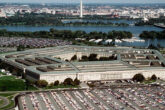June 27, 2017
Higher, Heavier, Farther, and now Undetectable?
Bombers: Long-Range Force Projection in the 21st Century
On Christmas Day in 1914, three former cross-channel packet ships, the Engadine, Empress, and Riviera, stood off the island of Heligoland in the North Sea. Under the watchful eye of the Royal Navy cruisers Arethusa and Undaunted, the three ships pulled back the tarps erected on their sterns and forecastles to reveal nine seaplanes. The aircraft – three Short Folders (Short was the company name; Folder was the model and denoted the aircraft’s ability to fold its wings for storage), four Short 74s, and two Short 135s – were assembled and carefully lowered into the water. The Folders had a 67-foot wingspan, were powered by a 160-horsepower engine, and weighed 3,040 pounds fully loaded. The other two models were derivatives of the original Folder and had similar, if not exact, characteristics. Seven of the nine aircraft were able to get airborne (the other two were unable to break the dynamic tension of the water) and headed eastward carrying three 20-pound Hale bombs apiece, each of which contained 4.5 pounds of explosives within 13 pounds of steel guided by aluminum tail fins. Combined, the 21 bombs had less destructive power than one 13-inch shell fired from a British battleship, but these weapons could be taken directly to their targets and dropped precisely on top of them.
The seven aircraft flew on, searching for their target, the 600-foot-long zeppelin hangar at Nordholz. However, a thick fog shielded the building from view, forcing the aircraft to drop their bombs on the hangar’s estimated position, with no effect. The aircraft then returned to their ships, landing nearly four hours after takeoff. The raid and several others that followed, ranging up and down the Belgian and German coastlines, were the products of the planning and thinking of Squadron Commander Charles R. Samson.
Experience began to reveal shortcomings in the British method of attack. Samson realized he could not go far enough to reach the really important targets nor was he carrying enough bombs that were large enough to have the desired effect.
Samson sought targets that mattered: zeppelin sheds, railway stations, bridges, and submarine piers. Experience, however, began to reveal shortcomings in the British method of attack. Samson realized he could not go far enough to reach the really important targets nor was he carrying enough bombs that were large enough to have the desired effect.
Nearly nine decades later, on October 8, 2001, two large black objects looking much more like spacecraft than strategic bombers took off from Whiteman Air Force Base, Missouri, near Kansas City, close to the geographic center of the continental United States. These huge tailless flying wings, known as B-2 Spirits or “stealth bombers,” were to follow two other B-2s that had taken off the previous night to attack targets in Afghanistan. In total, six B-2 bombers would strike an enemy that thought itself safe in its sanctuary halfway around the world. The six B-2 missions were spread out across the first three nights of the operation, from October 7–9.1 Afghanistan’s Taliban government had not surrendered the terrorists located within its borders to face justice after the cowardly attacks of September 11, so the United States brought justice to Afghanistan. The primary mission of these stealth bombers, manned by two pilots each, was to sneak into enemy territory and attack airfields and air defenses to secure air superiority for the non-stealthy aircraft that would be carrying out subsequent attacks in the coming weeks.
The six bombers all headed west, for operational security reasons, on course to traverse the Pacific Ocean, past India, and then head north over the Indian Ocean toward their targets. The flight over the Pacific took 24 hours alone. Four refuelings from airborne tankers later, the aircraft crossed “feet dry” over Pakistan just as the sun set. On October 9, the second wave of two aircraft split up and conducted individual bomb runs on multiple targets throughout Afghanistan. During some bomb runs, the B-2 pilots used their onboard synthetic aperture radar to put eyes on targets to refine target coordinates before releasing their satellite-guided precision bombs or Joint Direct Attack Munitions (JDAMs). A combination of the B-2’s stealth characteristics, endurance, and modern onboard sensors allowed the pilots to take their time while deep in enemy territory and methodically provide their own last-minute intelligence, surveillance, and reconnaissance (ISR) update to find, fix, and target any threats that had popped up or changed position since the bombers had taken off from the continental United States dozens of hours earlier. After spending about two hours over enemy territory prosecuting targets, the two crews exited the country and headed for the tankers waiting to provide the fuel for the last leg of the trip. A radio call came over secure communications from the Air Operations Center asking the crew of the B-2 aptly named Spirit of America to return to Afghanistan since it had four JDAMs remaining. The crew accepted the mission.
A combination of the B-2’s stealth characteristics, endurance, and modern onboard sensors allowed the pilots to take their time while deep in enemy territory and methodically provide their own last-minute intelligence, surveillance, and reconnaissance.
Low on fuel, the Spirit of America orbited over the Arabian Sea waiting for a tanker that would provide it the fuel needed for another trip into enemy territory. As the pilot flew behind the tanker while receiving fuel, the mission commander (the second pilot) programmed the new mission into the aircraft’s computers. After another 90 minutes over Afghanistan, the crew exited the combat zone a second time to find a waiting tanker ready to provide the required fuel to reach the B-2’s destination, the island of Diego Garcia in the Indian Ocean. Four hours later the Spirit of America touched down on the small island after being airborne for more than 44.3 hours, logging the longest combat mission in aviation history. For that crew the mission was over, but not for the Spirit of America. While the engines continued to run, the exhausted crew switched out with a pair of rested pilots. Maintenance personnel put oil into the running engines. Then, after the 45-minute pit stop, the new crews lifted the two bat-winged aircraft back into the sky for the 30-hour flight home to Missouri. In total, the Spirit of America and five other B-2s operated for more than 70 hours each over a three-night period, traversing the globe on those missions without stopping engines. Bombers had come a long way in 87 years, proving no enemy, no matter where it resided, was safe.2
As proved by this B-2 mission and many others, today’s bombers can successfully strike targets anywhere in the world and hold a nation’s enemies at risk in their own territory. Over time, bombers have developed and maintained this ability to operate deep in the enemy’s heartland where other weapon systems could not reach. This unique capability derives from a combination of three critical traits all bombers must possess in some dynamic combination, which may alter within a single mission: range, payload, and the ability to penetrate enemy defenses. This paper will trace the origins of bombers, primarily U.S. heavy bombers, from the before the First World War to today. The authors will introduce the theory, doctrine, and technology behind their development, as well as the performance characteristics and trends that combined to provide ever-increasing range, payload (or volume of fires), and most importantly the ability to penetrate constantly improving defenses. To accomplish the mission, bombers would initially depend on self defense and then progress to a reliance on other defenses such as fighter escorts, increasing altitudes, supersonic speeds, low-altitude penetration to fly below enemy radar, and, eventually, stealth technology to avoid or minimize radar detection. Following the historical analysis, the paper will focus on what this means for the next-generation American bomber, the B-21, and why the United States should continue to invest in the bomber as a concept and a platform.
The full report is available online.
More from CNAS
-
The Department of Defense’s Breakthrough Nuclear Moment Risks Slipping Away
Unless they act, the Department of Defense’s breakthrough nuclear moment may vanish before it really happens....
By Will Rogers
-
DEFAERO Strategy Series [Apr 09, 25] CNAS' Becca Wasser and Phil Sheers on Revitalizing the U.S. Defense Industrial Base
On this episode of the Defense & Aerospace Report Strategy Series, sponsored by General Atomics Aeronautical Systems, Becca Wasser and Phil Sheers of the Center for a New Amer...
By Becca Wasser & Philip Sheers
-
From Production Lines to Front Lines
Executive Summary The U.S. defense industrial base (DIB) is struggling to meet the demands of the current strategic environment—let alone prepare for a potential conflict agai...
By Becca Wasser & Philip Sheers
-
The Pentagon’s Endangered Brain Trust
In this environment, sound assessments of emerging threats and new ideas to counter them will be especially vital....
By Dr. Andrew Krepinevich, Jr.





